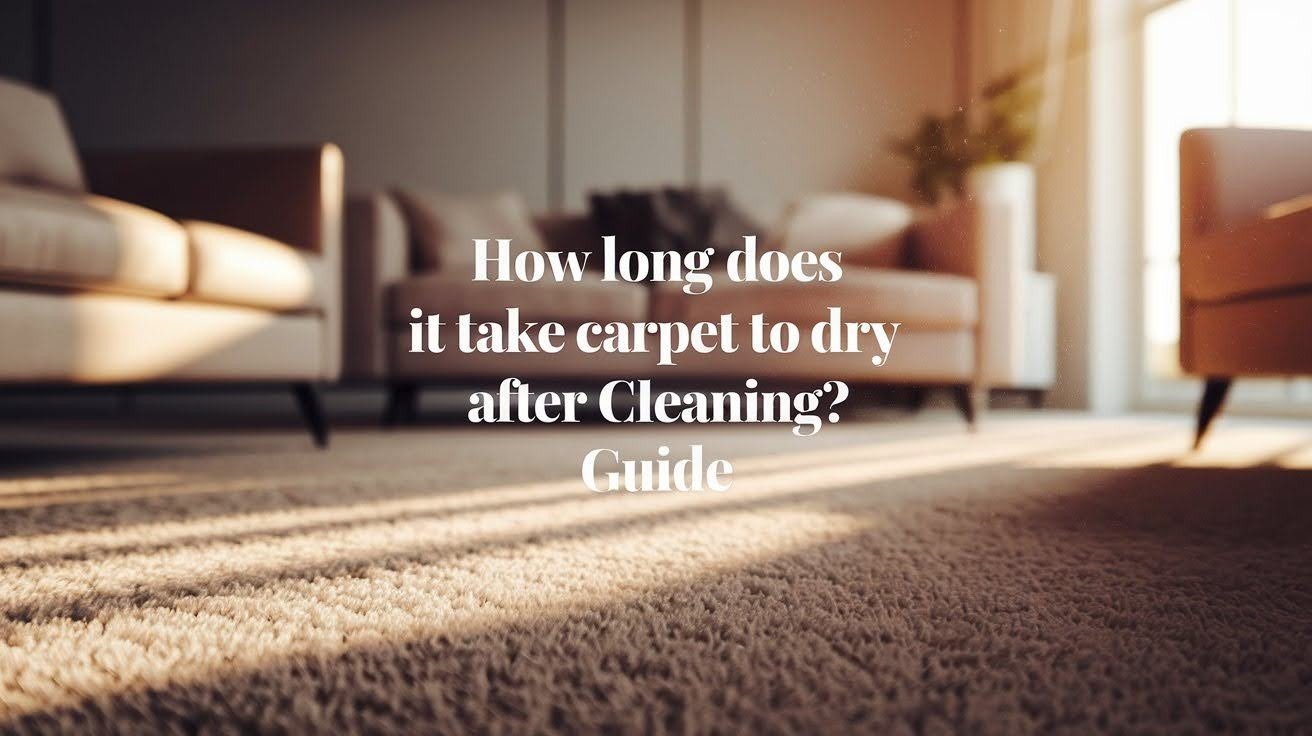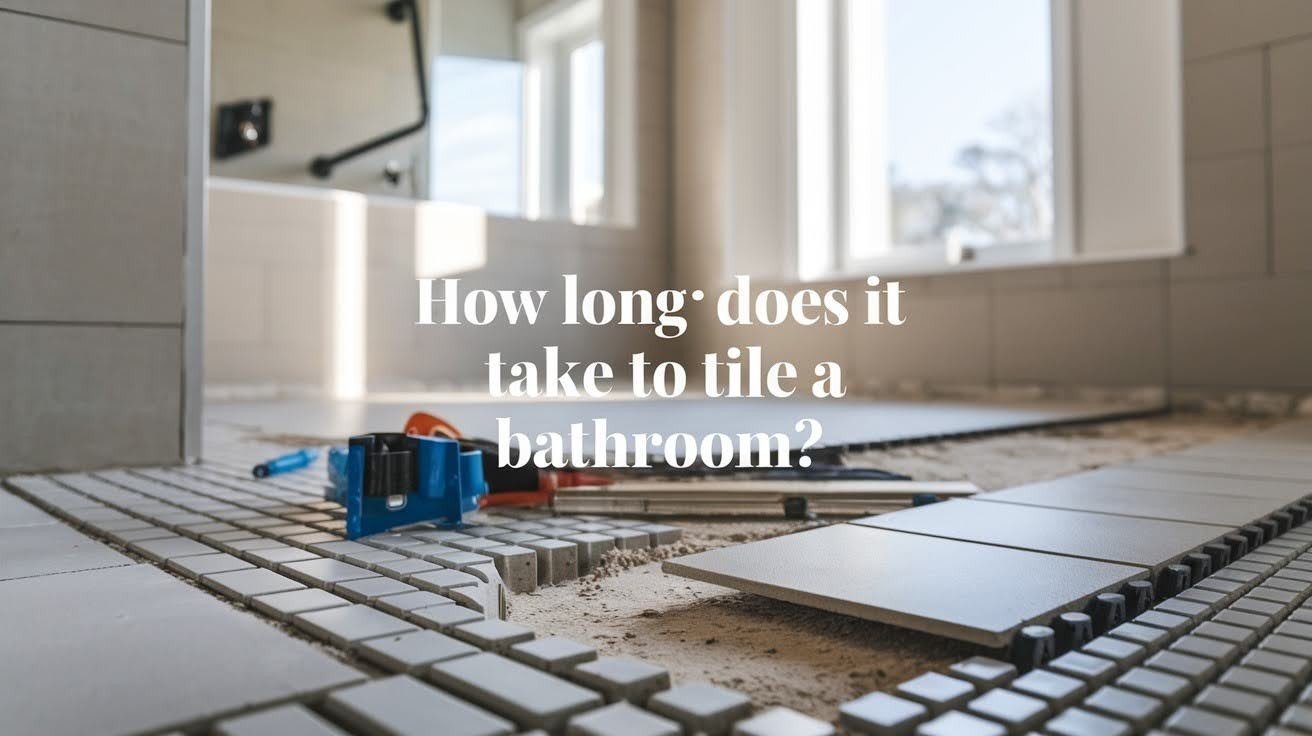You just had your carpets professionally cleaned, but now you’re staring at wet floors that seem to take forever to dry. This waiting game isn’t just annoying,it can lead to real problems if your carpets stay wet too long.
Knowing how long your carpets should take to dry helps you plan your day and spot potential issues early. The drying time depends on several factors that you can control.
As a carpet cleaning professional with over years of experience, I’ll share the exact timeframes you can expect and proven ways to speed up the process.
You’ll learn when to worry about slow-drying carpets and how to avoid common problems that many homeowners face.
How Long Does Carpet Take to Dry After Cleaning?
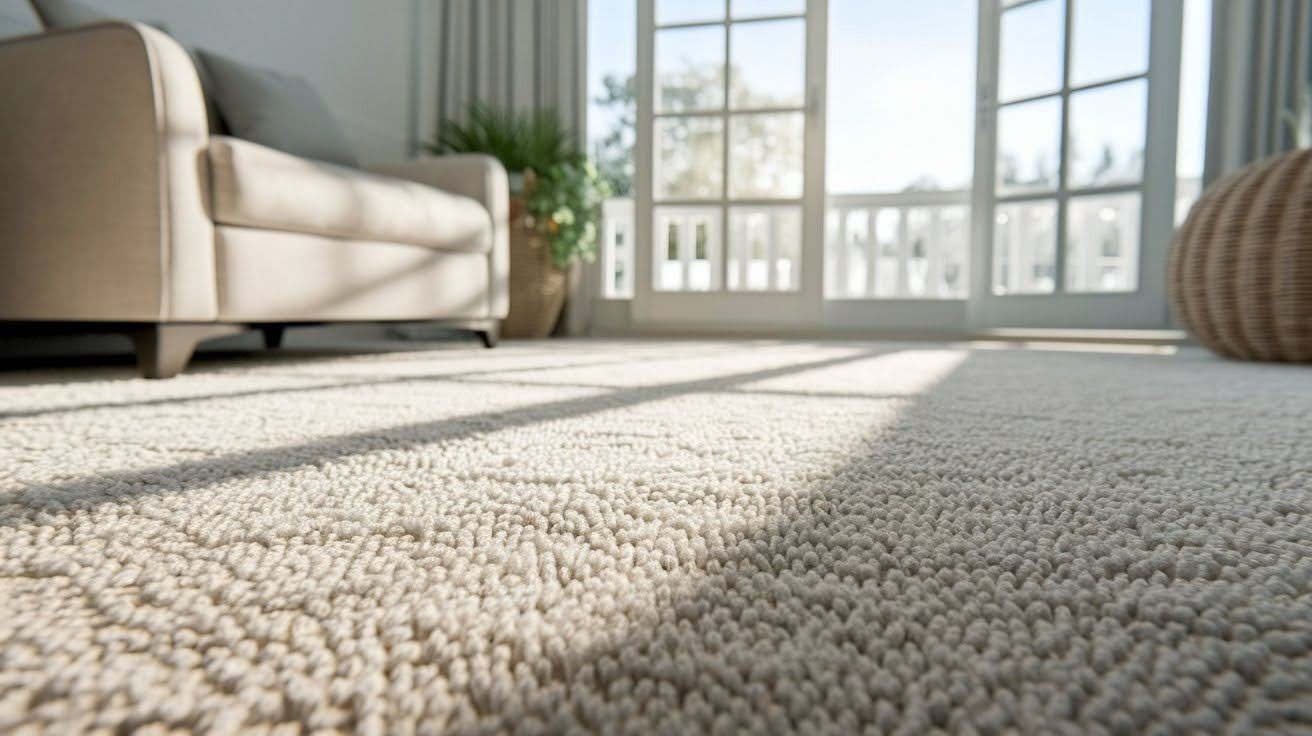
Most carpets take 6 to 12 hours to dry completely after professional cleaning. This timeframe works for standard hot water extraction, which most carpet cleaners use. The surface may feel dry in 2 to 4 hours, but the padding underneath needs more time.
Low moisture cleaning methods dry much faster. These techniques use less water and special cleaning solutions. Your carpets will typically dry in 2 to 4 hours with this method. However, this cleaning style works best for light soil and regular maintenance.
Several factors can make drying take longer or shorter than these standard times. Thick carpets with dense padding hold more water and need extra drying time. Thin carpets over concrete floors often dry faster than thick ones over wooden subfloors.
Complete drying means both the carpet surface and padding are moisture-free. Walking on carpets that feel dry on top but have wet padding underneath can cause new stains to appear and create health problems from trapped moisture.
What Affects Carpet Drying Time After Professional Cleaning
The drying time for your carpets depends on many factors working together. Understanding these helps you set realistic expectations and take steps to speed up the process.
Cleaning Method Used
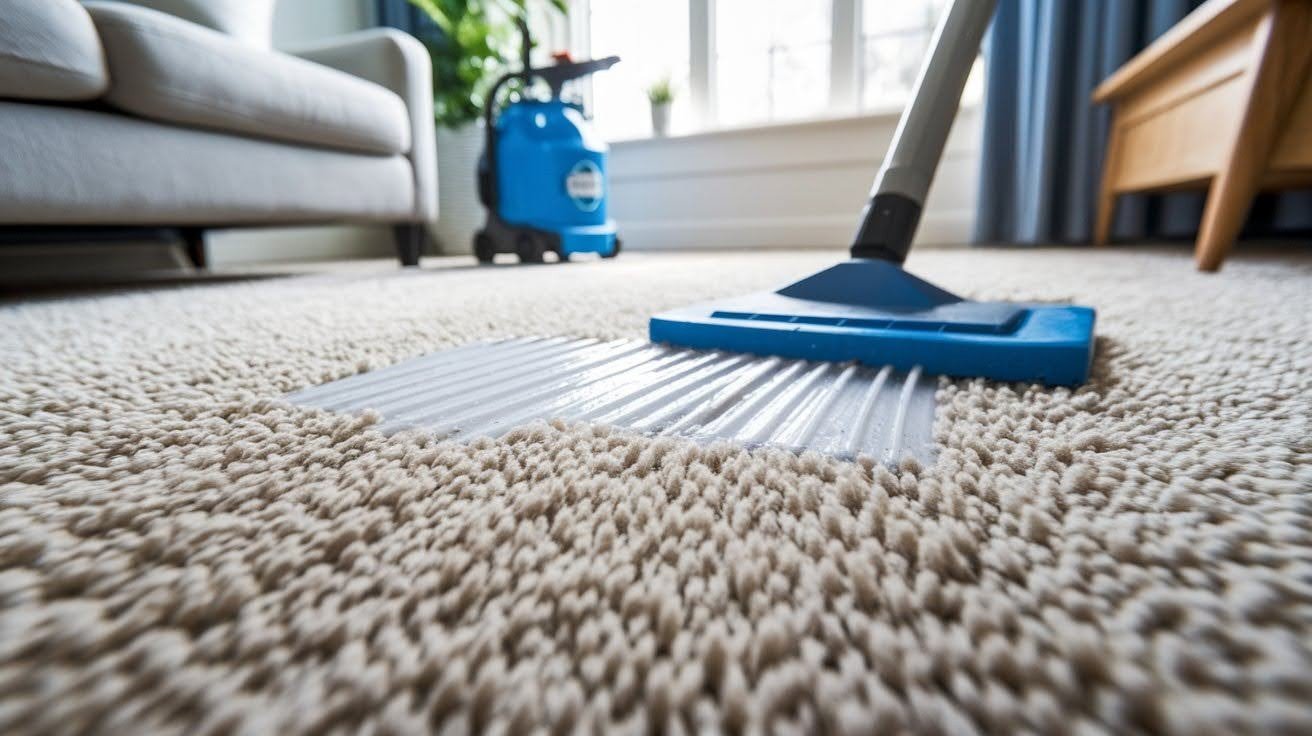
Steam cleaning pushes hot water deep into carpet fibers and then pulls it back out. This method removes more dirt but leaves more moisture behind. Professional equipment removes about 95% of the water used, but the remaining 5% needs time to dry naturally.
Low moisture cleaning uses special machines that scrub carpets with minimal water. These systems work with cleaning solutions that break down dirt without soaking the carpet. The result is faster drying but may not clean as deeply as steam methods.
Home carpet cleaning machines can’t match professional equipment’s power. They often leave much more water in carpets because their suction isn’t strong enough. This extra moisture can double or triple normal drying times.
Carpet Material and Construction
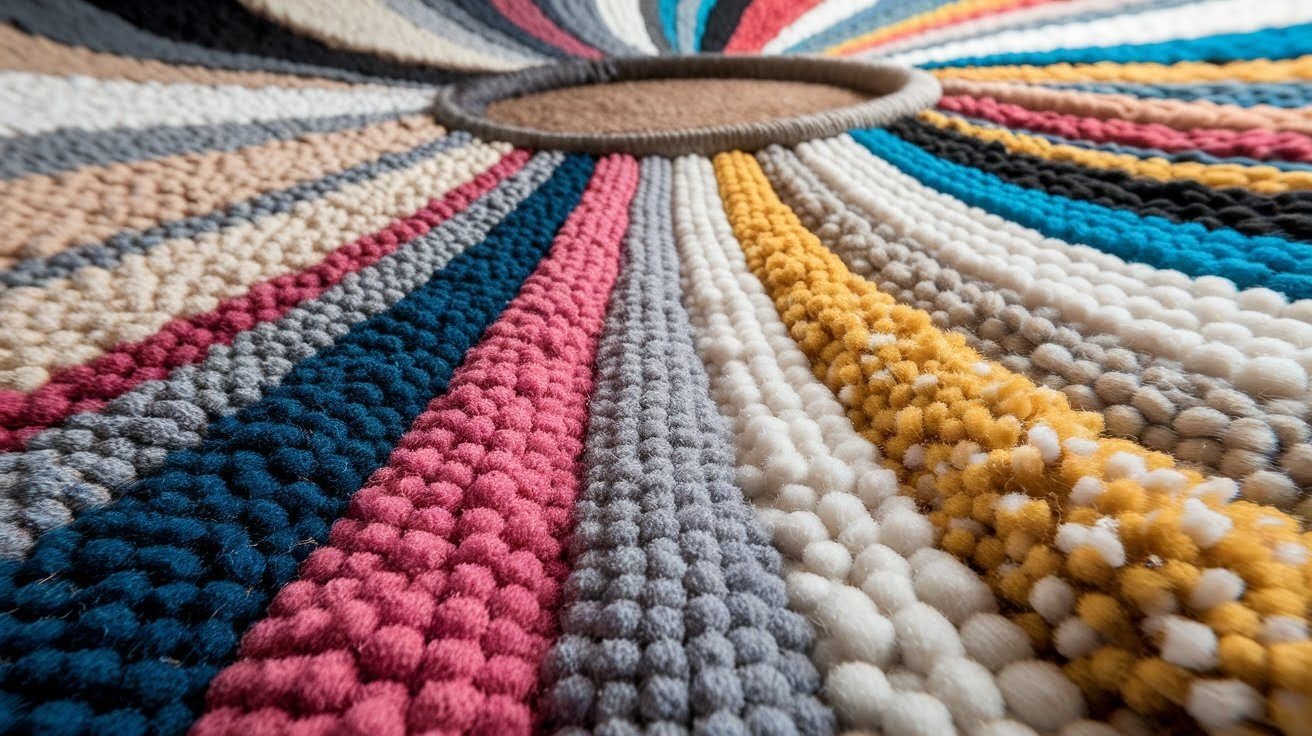
Wool carpets absorb and hold more water than synthetic materials. They also take longer to release moisture back into the air. Nylon and polyester carpets dry faster because they don’t absorb water as readily as natural fibers.
Thick, dense carpets trap more cleaning water in their fibers. The tighter the weave, the longer water stays trapped inside. Low-pile carpets with loose construction allow air to move through more easily, speeding up drying.
The padding under your carpet affects drying time significantly. Foam padding holds less water than fiber padding. Rubber padding creates a barrier that slows moisture from moving up and out of the carpet system.
Room Conditions
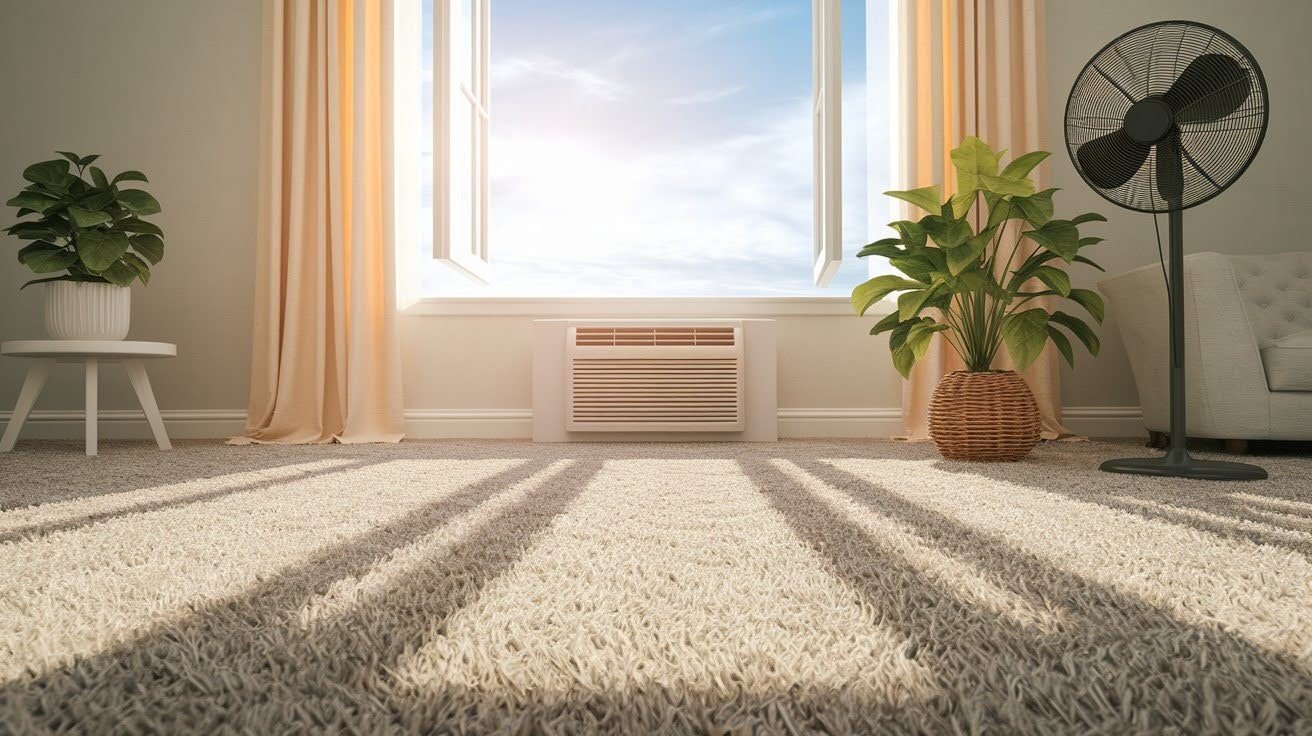
High humidity in your home slows down carpet drying dramatically. When the air already holds lots of moisture, it can’t absorb much more from your wet carpets. Ideal humidity levels for fast drying stay below 50%.
Warm air holds more moisture than cold air, which speeds up the drying process. Rooms kept at 70-75°F dry carpets faster than cooler spaces. However, very hot temperatures can damage some carpet fibers and should be avoided.
Good air movement helps moisture leave your carpets quickly. Rooms with fans, open windows, or active air conditioning systems create the airflow needed for fast drying. Still air in closed rooms keeps moisture trapped near the carpet surface.
How to Speed Up Carpet Drying Time?
You can take several steps to make your carpets dry faster after cleaning. These methods work best when used together rather than trying just one approach.
Improve Air Circulation
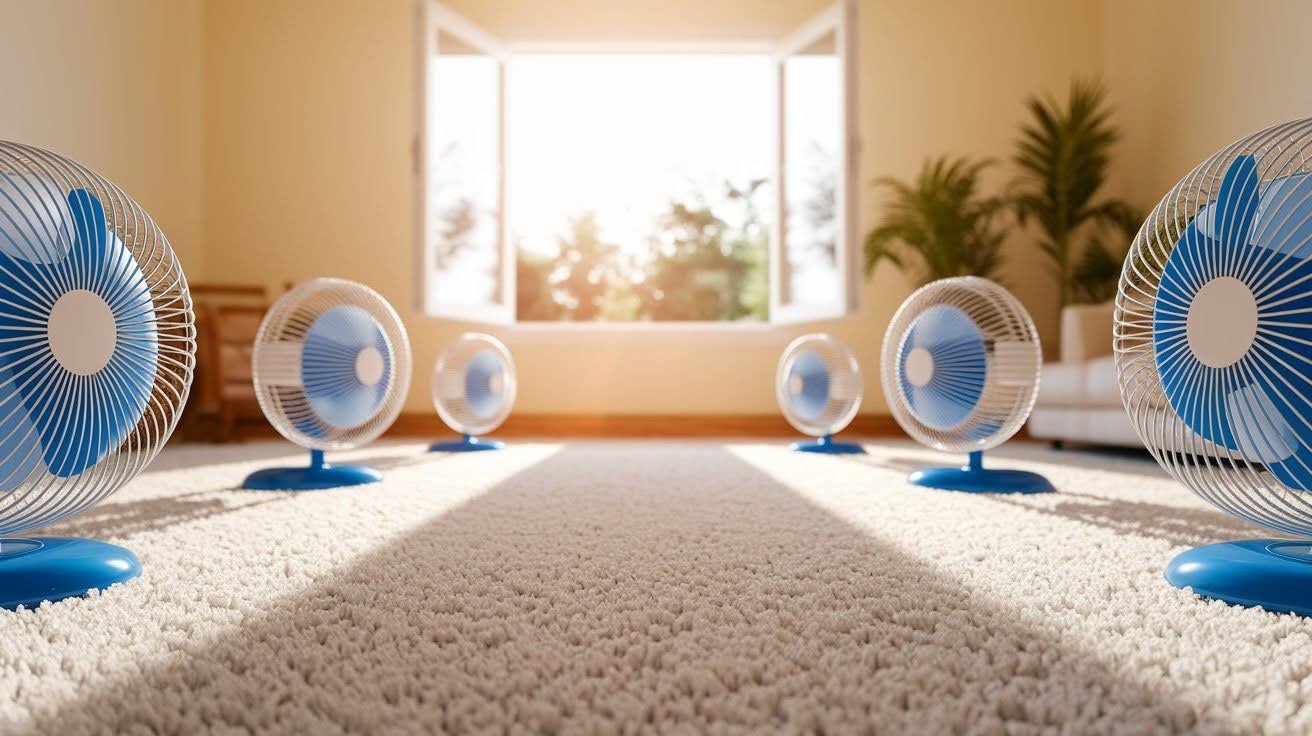
Place fans around the room to create steady airflow across the carpet surface. Position them so air moves parallel to the floor rather than straight down. Box fans work better than ceiling fans because they move more air at carpet level.
Open windows and doors when outside weather conditions help with drying. Dry, breezy days with low humidity create perfect conditions for fast carpet drying. Avoid opening windows on humid or rainy days, as this adds moisture to your indoor air.
Run your heating and cooling system with the fan set to “on” instead of “auto.” This keeps air moving throughout your home, even when the temperature doesn’t need adjustment. Clean air filters before starting this process to ensure maximum airflow.
Control Indoor Climate

Use a dehumidifier to pull excess moisture from the air in rooms with wet carpets. Set the humidity level to 30-40% for optimal drying conditions. Empty the water collection tank regularly to keep the unit working efficiently.
Air conditioning removes humidity while cooling the air, creating ideal drying conditions. The cool, dry air can absorb moisture from your carpets more effectively than warm, humid air. Run the AC even if the temperature feels comfortable.
Space heaters can speed drying in small areas, but use them carefully. Keep heaters at least 3 feet away from wet carpets to prevent damage or fire risk. Never leave space heaters running unattended or overnight.
Professional Assistance
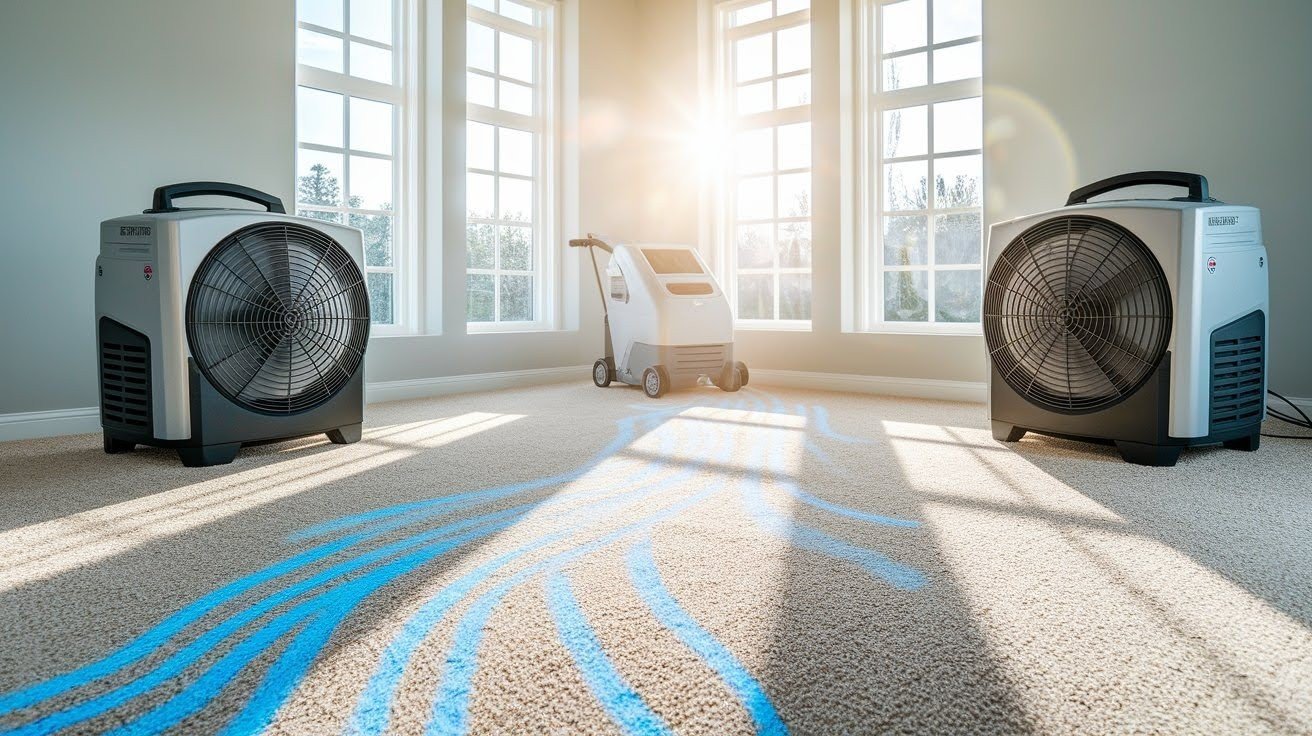
Ask your carpet cleaner about blow-dry services when booking your appointment. Many companies offer high-powered fans or air movers as an add-on service. These industrial fans move much more air than household fans.
Professional extraction equipment removes more water during cleaning, reducing drying time significantly. Some companies offer multiple extraction passes or specialized drying equipment. This service costs more but can cut drying time in half.
Schedule your carpet cleaning on days with good weather conditions. Avoid rainy, humid days when possible. Spring and fall often provide the best conditions for fast carpet drying in most climates.
Why Proper Carpet Drying Matters?
Complete drying prevents serious problems that can cost much more than the original cleaning. Mold and mildew growth start quickly in wet carpet environments, especially in warm conditions. These fungi create health problems and permanent damage to your carpet and home.
Wet carpets attract dirt and stains much faster than dry ones. Walking on damp carpets can push soil deep into the fibers, making your carpets look dirty again within days. This defeats the purpose of professional cleaning and wastes your money.
Moisture trapped under carpets can damage wooden subfloors, create warping, and lead to expensive repairs. Some carpet warranties become void if proper drying procedures aren’t followed after cleaning. Insurance companies may also deny claims related to water damage from improperly dried carpets.
Signs Your Carpet Isn’t Fully Dry
Knowing when your carpet still needs more drying time helps prevent problems before they start.
Your carpet should smell fresh and clean when fully dry. Musty, sour, or damp odors mean moisture is still trapped somewhere in the carpet system. These smells often get stronger in the first 24 hours if drying isn’t progressing properly.
- Cool or cold spots when you touch the carpet surface
- Water appears when you press down firmly on the carpet
- Dark or discolored areas that weren’t there before cleaning
- Carpet feels spongy or soft underfoot
- Visible water marks or rings around furniture legs
Take action within 24 to 48 hours if these signs appear. Mold and mildew can start growing in this timeframe when conditions are right. Contact your carpet cleaner immediately if drying isn’t progressing normally after the first day.
Conclusion
Most carpets need 6 to 12 hours to dry completely after professional cleaning, though low moisture methods can finish in 2 to 4 hours. The cleaning method, carpet type, and room conditions all affect how long this process takes.
Speed up drying by improving air circulation with fans, controlling humidity levels, and maintaining proper room temperature. Watch for warning signs like musty odors or cool spots that indicate incomplete drying.
Proper drying protects your health, prevents damage to your home, and keeps your carpets looking great longer. When drying takes longer than expected or problems develop, contact your carpet cleaning professional right away for guidance and possible solutions.
Frequently Asked Questions
Can I Walk On My Carpet While It’s Still Drying?
Limit foot traffic on damp carpets to prevent re-soiling and safety issues. Wear clean socks or shoe covers if you must walk on the carpet.
What Should I Do If My Carpet Smells After Cleaning?
Post-cleaning odors usually indicate incomplete drying or cleaning residue. Increase air circulation and contact your cleaner if smells persist after 24 hours.
Is It Normal for Carpet to Feel Damp the Next Day?
Surface dampness can be normal for thick carpets, but the carpet should feel mostly dry. Deep moisture after 24 hours may indicate a drying problem.
Can Cold Weather Affect How Long My Carpet Takes to Dry?
Cold temperatures slow evaporation significantly. Winter carpet cleaning often requires extra drying time and may need indoor heating assistance for proper results.
Should I Run My Air Conditioner to Help Carpets Dry Faster?
Yes, air conditioning removes humidity while creating air movement, both helpful for faster drying. Combine with fans for the best results and energy efficiency.

